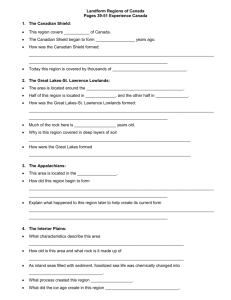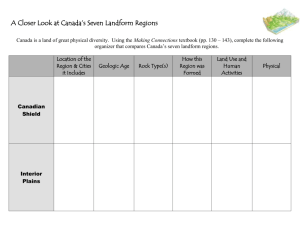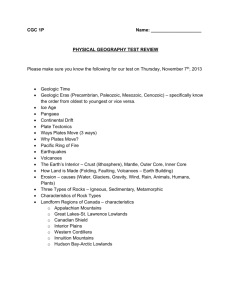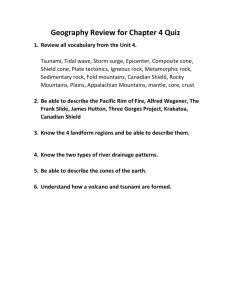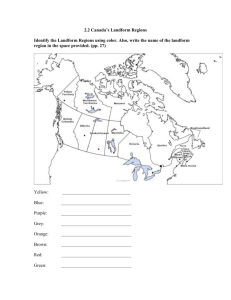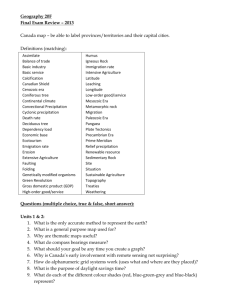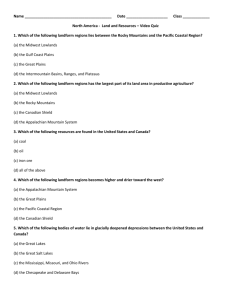Canada*s Physiographic regions.
advertisement
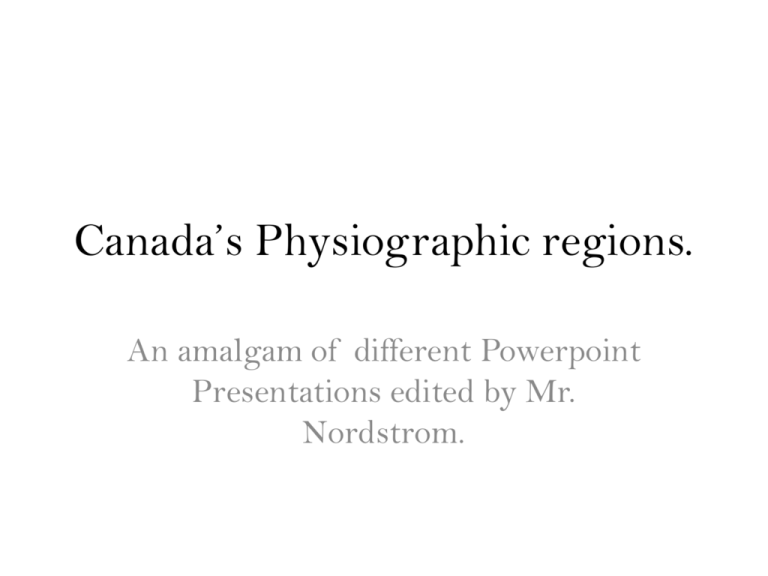
Canada’s Physiographic regions. An amalgam of different Powerpoint Presentations edited by Mr. Nordstrom. BC Curriculum BC curriculum part 2 This Powerpoint. • I have edited a few different Powerpoints that I found online. You will be able to see the root ideas based on the formatting of each slide. LANDFORM REGION MAP OF CANADA Sometimes the term ‘Landform Region’ is replaced by the term ‘Physiographic Region’ Western Cordillera •This region is made up mountain ranges – The Coast Mountains, the Columbia Mountains, and the Rocky Mountains, separated by plateaus. •The height of many of these mountains reaches over 3000 m. •This region includes British Columbia, Yukon Territory, and part of Alberta. • If you looks carefully, you will also see glaciers WESTERN CORDILLERA The term ‘cordillera’ means mountain or mountainous. In Canada, the Western Cordillera region covers most of British Columbia and the Yukon Territory. The great height and rugged appearance of the mountains tell us they are very young. The collision of the North American and the Pacific plates uplifted the region into several mountain ranges. The mountains and valleys of the Western Cordillera run in a northsouth direction. Many people use the term ‘Rocky Mountains’ to describe the Western Cordillera – but, in truth, the Rockies are just a small part of the Western Cordillera. There are three major divisions of the Western Cordillera. The Rocky Mountains and the Columbia Mountains, along with several other ranges make up the eastern part of the region. The Rocky Mountains are formed of folded and faulted sedimentary rock which contain many fossils. The Columbia range, while also made up of sedimentary rock contains many intrusions of metamorphic rock. The Rocky Mountains Unlike flat regions, mountains are known for fast-flowing rivers which gouge steep valleys in the landscape WEST COAST MOUNTAINS • Subduction zone • Oceanic plate sliding under continental plate • Prone to earthquakes WEST COAST MOUNTAINS • • INDUSTRIES TAKE ADVANTAGE OF THE RESOURCES AND LANDFORMS OF THE AREA WHISTLER ATTRACTS A SIGNIFICANT NUMBER OF …. INTERIOR PLAINS The Interior Plains in Canada are often called the Prairies. This region extends from the US border in the south to the Arctic Ocean in the north. It makes up the southern parts of Manitoba and Saskatchewan, almost all of Alberta and the western part of the Northwest Territories. The Interior Plains are made up of sedimentary rock since long ago this area was covered by shallow seas. Most of the oil and gas in Canada is locate in this region. The Prairies Differential erosion has caused the formation of several escarpments resulting in four different levels of elevation on the Prairies. Three of these regions are located in the southern part of the Interior Plains and the other in the north. On the western part of the Interior Plains is the Alberta Plains – including the foothills of the Rockies. Foothills of Alberta Interior Plains • Is located between the Shield and the Western Cordillera • In parts of the Plains, the soil is more than 25 cm deep, which is black earth. This is ideal for growing wheat. Interior Plains • The Cypress Hills in Southern Saskatchewan Interior Plains • • The Qu’Appelle Valley in Southern Saskatchewan A rare change from the flat landscape in this region The Interior Plains Economy • Agriculture is one of the most important activities in the Interior Plains • What other major resource activity takes place there? Transport on the Prairies Canada’s wheat basket requires many kilometers of rail lines to deliver wheat to Vancouver, Hudson Bay and Thunder Bay CANADIAN SHIELD The Canadian Shield is the geographic foundation of Canada. More than half of Canada is covered by the Shield. Metamorphic and igneous make up the Shield – it contains some of the oldest rocks in the world. Once a major mountain region, the Canadian Shield is now relatively flat with rounded rocky hills. The Canadian Shield The area has been subjected to a number of major glaciations. The scraping and gouging action of the ice has left depressions in the bedrock which have filled with water to form hundreds of thousands of lakes. The bedrock is impervious – water does not pass through it. The sand and gravels deposited by the glaciers (from the scraping and gouging) have forced the rivers to flow in many different directions – resulting in a very disorganized pattern of winding rivers, lakes and swamps. Rocky Outcrops CANADIAN SHIELD Gouges and Scrapes Hundreds of Lakes Poor Drainage Patterns Rocky Outcrops Canadian Shield • This region is mostly covered with coniferous forests with a few areas suited for agriculture. • Covers Central Canada: Saskatchewan, Manitoba, Ontario, Quebec, Labrador, the Northwest Territories, and Nunavut. Canadian Shield • The rocks of the Canadian Shield are about four billion years old. • Notice the scratches in the rock • They were caused by glaciers Canadian Shield • A boulder in the Northwest Territories • It was deposited here by a retreating glacier TYPICAL FEATURES OF THE CANADIAN SHIELD • What does the vegetation tell you of the location of this part of the Shield? • Name two typical features of the Shield shown by this picture HUDSON BAY LOWLANDS [a region in the Canadian Shield] Around the southwestern shore of Hudson and James Bay is a very flat, low area covered by swampy forest called the Hudson Bay Lowlands. This area has layer of sedimentary rock resting on top of the ancient rocks of the Canadian Shield. Muskeg In this region the swampy areas are called muskeg – the water is often stagnant. Several rivers meander through the area. The vegetation is mostly bushes and isolated trees. Poor Vegetation Hudson Bay Lowlands GREAT LAKES – ST. LAWRENCE LOWLANDS The Great Lakes – St . Lawrence Lowlands consists of two regions. The Great Lakes Lowlands are located in Southern Ontario. The lowlands are formed from sedimentary rock – and there are several escarpments in the area – the most famous is the Niagara Escarpment which extends from Niagara Falls to Manitoulin Island. Niagara Escarpment The Great Lakes portion of the lowlands was subjected to many glaciations in the past – creating a rolling landscape. Several major glacial features are evident in the landscape – including eskers, drumlins and moraine. A significant moraine – the Oak Ridges Moraine runs for about 160 km – parallel to Lake Ontario . Oak Ridges Moraine Great Lakes St. Lawrence Lowlands • Most southerly and smallest landform region of Canada • Newest landform region • Formed by the action of glaciers scraping away and re-depositing material on the landscape • Consists of lakes, valleys and rolling hills Great Lakes - St. Lawrence Lowlands • Why would landforms of this region favour large scale settlement? • Densely populated • Many of Canada’s largest cities • What is meant by the term ‘high density’? Gt. Lakes - St. Lawrence Lowlands Great Lakes – St. Lawrence Lowlands The city of Montreal • The city of Toronto Great Lakes – St. Lawrence Lowlands • Farmers grow grapes, peaches, pears and other fruits Farmland near Toronto APPALACHIAN REGION The Appalachian Mountains runs through the Gaspe Peninsula of Quebec, into the Maritimes provinces and all the way to Newfoundland. They are the oldest highland region in Canada – formed when North American collided with Europe and North Africa during the formation of Pangaea. Low Mountains These mountains are made of mainly sedimentary rock though there are areas where volcanic activity and faulting have created igneous and metamorphic outcroppings. Millions of years of erosion have reduced the once jagged peaks to rolling mountains and hills. More recent glaciations have added to the leveling of these mountains. Wide Eroded Valleys The Maritimes • While the Atlantic provinces have relatively poor economies, still many people want to live there. • What features of Atlantic life would encourage people to live there? Appalachian Mountains • This region covers most of Atlantic Canada – New Brunswick, Nova Scotia, PEI and Newfoundland. Appalachian Mountains • It is thought they were formed about 375 million years ago • These mountains have been worn down by ice and water over the years. Their typical height is 1000 m. • The vegetation is a mix of coniferous and deciduous forest. ARCTIC LOWLANDS AND INNUITIAN MOUNTAINS The Arctic Lowlands and Innuitian Mountains are the last of the landform regions in Canada. They occupy the northern part of the country – basically everything north of the Canadian Shield. The Arctic Lowlands are made up of a series of islands and have a gently rolling landscape and are mostly sedimentary in structure. Innuitian Mountains The Innuitian Mountains form the northern edge of the country and are primarily made of igneous and metamorphic rocks with some areas of sedimentary bedrock. Arctic Lowlands Arctic Lowlands • Most of the Arctic Lowlands are located in Nunavut. • A short growing season allows for only sparse vegetation of lichens and moss. Arctic Lowlands • This is a region of tundra, a treeless plain, with a cold, dry climate and poorly drained soil. Innuitian Mountains • In the Far North, the Innuition Mountains have rugged peaks that rise over 2000 m with steep sided valleys. • The dramatic cliffs of Ellesmere Island, Nunavut Innuitian Mountains • This area is too cold for trees to survive. • A glacier and its melt water on Ellesmere Island, Nunavut Innuitian Mountains • Red rocks and barren landscape on Melville Island • Melville Island is divided between Nunavut and the Northwest Territories
